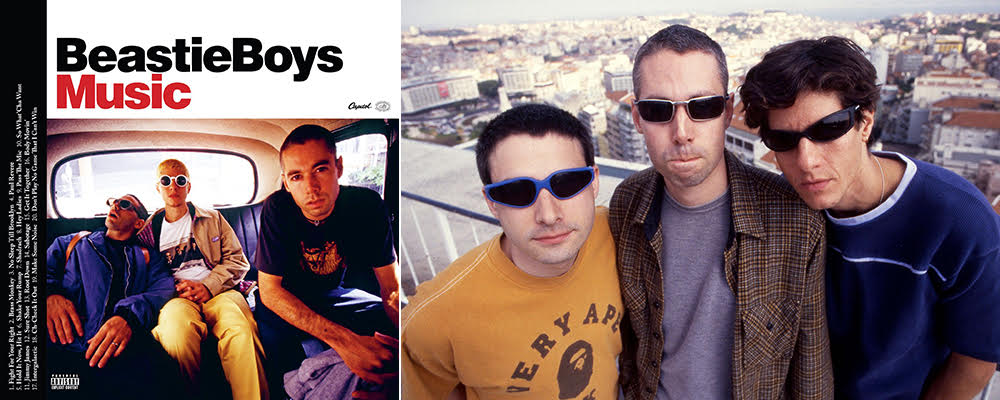‘Beastie Boys Music’ Scratches at the Surface of the Group’s Artistic Evolution
Todd Gilchrist
It is wild to consider how successfully the Beastie Boys navigated the edges of a music and a culture that, quite frankly, was not their own. Even if most of their biggest achievements preceded the era of properly discussing cultural appropriation, what resonates most vividly in their music is how true to the spirit of hip-hop their music is without them ever trying to be anything that they weren’t.
“Beastie Boys Music” offers a semi-obligatory compilation album to go with their Mike D and Ad-Rock’s extraordinary 2018 biography of the group, “Beastie Boys Book,” and its staged 2020 version “Beastie Boys Movie,” a collection of many of the group’s biggest moments, but more importantly, a chronicle of their artistic evolution over almost 40 years. Diehard fans are likely to be less satisfied with this album than folks simply looking for an overview of their work, but “Beastie Boys Music” nevertheless charts the path that they followed to become the most successful and enduring white rap group of all time.
The immediate problem with “Music” is that it follows two very good Beastie Boys compilations, the two-disc anthology “The Sounds of Science” and “Solid Gold Hits.” The first was released in 1998 and the other in 2005, so what this new disc mostly does is add highlights from their 2011 album “Hot Sauce Committee Part Two” to an already-expansive collection of chart-topping standards, from “You Gotta Fight For Your Right To Party” up through “Don’t Play No Game That I Can’t Win.” They include five tracks from their 1986 debut “Licensed To Ill,” three from their 1989 Dust Brothers-produced masterpiece “Paul’s Boutique,” three from 1992’s “Check Your Head,” four from 1994’s “Ill Communication,” only two from “Hello Nasty,” which Ad-Rock called “their best album” in “Beastie Boys Book,” two from “Hot Sauce Committee” and just one from “To the 5 Boroughs.”
To some extent, “Beastie Boys Book” guides their choices here, at least insofar as the emphasis they put on each album: “Licensed To Ill” receives the most real estate in the book, for example, so it’s understandable they would include five tracks here, even if they have shown demonstrably less affection for that album after its heyday. But if you grew up with the band, witnessing their growth as rappers and musicians firsthand, then this set will almost certainly leave something to be desired. To be fair, that’s probably true of every Greatest Hits album ever assembled — fans will almost invariably gravitate toward deep cuts or tracks that weren’t played to death on the radio. The Beasties, however, chugged along in such a unique way that each album seemed to arrive at an equally distant, equally pivotal moment; almost like stages of listeners’ maturity coinciding with the band’s, which means that an overview of their discography does a slight disservice to the progress they (and we as fans) made.
In which case, you might miss “Rhymin and Stealin” from “Licensed To Ill,” “Professor Booty” from “Check Your Head,” or “Triple Trouble” from “To the 5 Boroughs,” among many other cuts equal in quality to what was included but perhaps not as commercially successful. Moreover, “Music” excludes all of the tracks from their instrumental album “The Mix-Up,” which isn’t a tremendous loss but as a snapshot of the band’s career, it ignores a few important digressions. But with this many absolutely fantastic tracks, how much can you complain? From the speaker-ripping bass under the chorus of “Shake Your Rump” to the propulsive horn blast anchoring “Ch-Check It Out,” few greatest hits collections feel this consistently fun from start to finish — and quite frankly, if this gets more people revisiting their impressively eclectic discography, much less listening to the scattershot but quite enjoyable “Hot Sauce Committee,” then it’s all worth it.
Throughout their career, the Beastie Boys consistently changed directions and subverted expectations — most of all their own, according to their memoir. What you can learn about them over the course of its almost 600 pages is, of course, more detailed, in depth, and idiosyncratic. Indeed, perhaps the only thing better than a retrospective of music made by the Beastie Boys is a curated list of all of the artists, songs and albums they referenced, grew up on, or took inspiration from throughout the years. But as a snapshot of their work, or maybe an intriguing aperitif encouraging listeners to dig deeper into their discography, “Beastie Boys Music” almost predictably understates exactly what its title promises but still manages to deliver.
“Beastie Boys Music” releases Oct. 23 on Apple Music.

